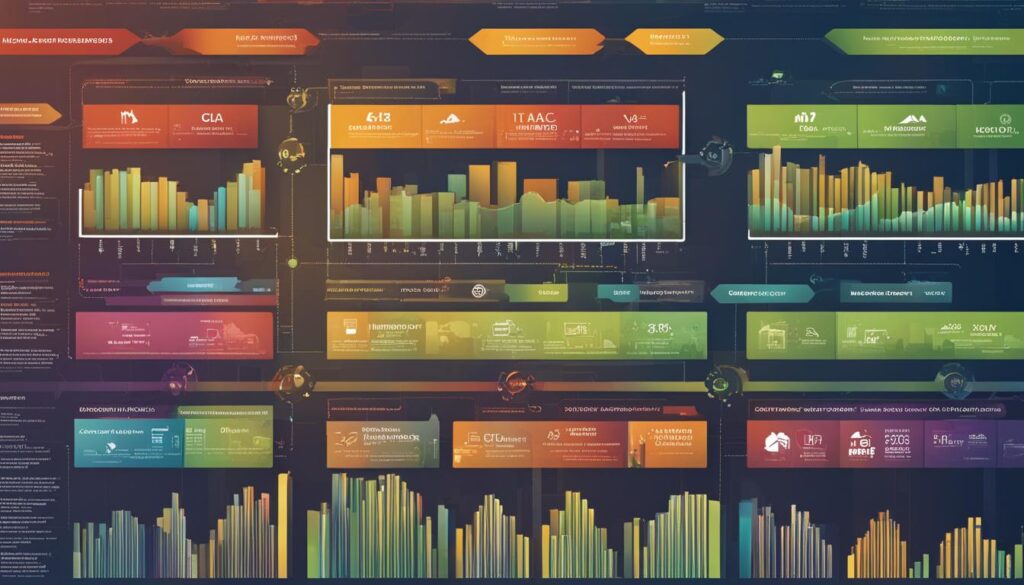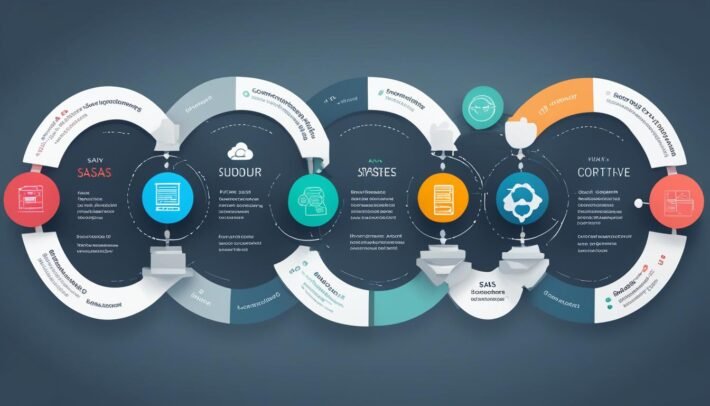SAAS Trends and Future Outlook: What Lies Ahead

The SAAS industry is one of the fastest-growing sectors in the software landscape, with businesses of all sizes increasingly relying on cloud-based solutions. From industry-specific software to personalized solutions, SAAS innovations are transforming the way companies operate, collaborate, and expand globally. With changing user demands and advancements in technology, it is crucial to stay up-to-date with the latest trends in the industry to remain competitive.
In this article, we will explore the current SAAS trends and discuss the future outlook for SAAS software. We will delve into the latest developments and innovations shaping the SAAS landscape and analyze how they will impact the industry in the years to come.
Key Takeaways:
- SAAS innovations are shaping the software landscape and transforming the way companies operate.
- Staying up-to-date with the latest trends is crucial for businesses to remain competitive.
- Advancements in technology and changing user demands will impact the future prospects of SAAS software.
- Data security, customer expectations, and globalization are key factors shaping the SAAS industry.
- SAAS providers must focus on customer success and support to ensure satisfaction and build long-term relationships.
Understanding SAAS Trends
Software as a Service, commonly known as SAAS, is a rapidly evolving industry with new trends emerging each year. In this section, we will explore the latest trends in the SAAS industry and how they are shaping the software landscape.
One of the most notable trends in the SAAS industry is the shift towards a more personalized user experience. SAAS providers are now offering tailor-made solutions to meet the specific needs of their clients. This trend not only increases customer satisfaction but also helps to differentiate the provider in a crowded market.
Another significant trend in the SAAS industry is the rise of AI and machine learning. SAAS providers are increasingly incorporating intelligent algorithms into their software to automate processes and improve efficiency. This trend is expected to continue in the coming years as further advancements are made in AI and machine learning technology.
Data security and privacy are also major concerns in the SAAS industry. SAAS providers must ensure that their software is compliant with privacy regulations and that user data is protected from potential breaches. The incorporation of blockchain technology is also expected to play a crucial role in enhancing data security in SAAS applications.
The SAAS industry is also seeing a growing demand for vertical solutions that cater to specific industries. Providers are developing industry-specific software that can meet the unique needs of the business. This trend is gaining popularity as it enables companies to streamline their workflows and boost efficiency.
Interoperability is another trend that is gaining traction in the SAAS industry. SAAS software is increasingly required to integrate with other software systems, enhancing the user experience and providing seamless workflows. With the API economy in full swing, interoperability is set to become a fundamental feature of SAAS applications.
Finally, the subscription model is also evolving, with providers now offering a wider range of pricing models to cater to different needs. Customer retention is crucial in the SAAS industry, and providers are developing strategies to keep their customers loyal for the long term.
The Latest SAAS Trends – A Summary
The latest trends in the SAAS industry illustrate a growing demand for personalized solutions, the incorporation of AI and machine learning, and increased emphasis on data security and privacy. The rise of vertical SAAS solutions, the importance of interoperability, and innovative subscription models are also making waves in the industry.
The Future of SAAS
SAAS software is constantly evolving to meet the changing needs of businesses and consumers alike. The future of SAAS promises to be exciting, as technological advancements open up a world of possibilities for software development.
One key trend for the future of SAAS is the increasing focus on personalization and customization of software solutions. As businesses become more specialized and individualized, SAAS providers will need to offer tailored solutions to meet unique needs. This means that flexible and scalable software will be in high demand, allowing businesses to customize the features and functions they need without paying for unnecessary extras.
Another area of innovation is the use of artificial intelligence (AI) and machine learning to improve SAAS functionality. AI-powered automation can help businesses reduce costs and improve efficiency, while intelligent algorithms can optimize workflows and predict user behavior.
Data privacy and security will continue to be key concerns for SAAS providers and users alike. As regulations become more stringent, SAAS companies will need to ensure their solutions comply with international privacy laws. In addition, users will require greater transparency and control over their data.
The shift towards mobile-first technology will also drive the future of SAAS. With an increasing number of users accessing software through mobile devices, SAAS providers will need to prioritize mobile compatibility and responsive design.

SAAS Software Market Projections
| Year | Market Size (in billion USD) |
|---|---|
| 2021 | 158.2 |
| 2022 | 173.3 |
| 2023 | 190.1 |
| 2024 | 208.7 |
| 2025 | 229.6 |
The future of SAAS is bright, with projected market growth in the coming years. As software technology continues to evolve and address the changing needs of businesses and consumers, SAAS providers will need to remain agile and innovative to stay ahead of the curve.
Evolving Customer Expectations
With the increasing competition in the SAAS industry, customer expectations are evolving rapidly. Today’s customers demand personalized solutions and seamless user experiences that meet their unique needs. Providers need to address these changing customer expectations to remain competitive in the market.
To meet evolving customer needs, SAAS providers should focus on enhancing the user experience. This means building software that is intuitive, user-friendly, and highly personalized. It also means investing in customer support services and empowering customers to get the most out of their software applications.
One way to address customer expectations is by leveraging data to understand their needs better. Providers can gather feedback from customers and use analytics tools to analyze user data, which can help identify patterns and improve the user experience.
SAAS User Experience
Providing a seamless user experience is crucial for SAAS providers. This means optimizing software for different devices, providing responsive design, and ensuring accessibility. A positive user experience can lead to increased customer satisfaction, retention, and ultimately, revenue.
Personalization is key when it comes to improving the user experience. Providers should offer customization features that allow users to tailor the software to their unique needs. This can include personalized dashboards, workflows, and reports. By providing tailored solutions, providers can meet customer expectations and build long-term relationships.
The Importance of Personalized Solutions
| Benefits of Personalized Solutions | Challenges of Personalized Solutions |
|---|---|
| Increased customer satisfaction | Increased complexity in software development |
| Better user engagement | Higher cost of development |
| Improved user retention | Higher support and maintenance costs |
While there are challenges associated with providing personalized solutions, the benefits outweigh the costs. By building software that meets evolving customer expectations, SAAS providers can gain a competitive edge and drive growth in the market.
“SAAS providers need to put their customers at the center of everything they do. By offering highly personalized solutions and seamless user experiences, they can create lasting relationships and drive business growth.”
Data Security and Privacy
The issue of SAAS data security and privacy has become increasingly paramount in recent years. With the continuous growth of cloud-based services and increasing instances of data breaches, SAAS providers must protect user data and comply with privacy regulations.
SAAS providers must implement strict security measures to safeguard user data, including encryption, access controls, and data backups. Additionally, they must comply with privacy regulations, such as the General Data Protection Regulation (GDPR) and the California Consumer Privacy Act (CCPA).
Users also have a responsibility to protect their data by choosing strong passwords and keeping their software up-to-date. By taking proactive measures, SAAS users can further enhance their data security.
The Importance of SAAS Data Security and Privacy
With the increased reliance on SAAS applications for critical business functions, the consequences of a data breach or privacy violation can be severe. Not only can it lead to financial losses and reputational damage, but it can also result in legal consequences for both the SAAS provider and its users.
“Data breaches and privacy violations can lead to financial losses, reputational damage, and legal consequences for both the SAAS provider and its users.
As a result, SAAS providers must prioritize data security and privacy to maintain user trust and comply with regulations. By implementing strong security measures and complying with privacy regulations, SAAS providers can further enhance their offerings and stay competitive in the industry.
Integration and Interoperability
Integration and interoperability have become key concerns for SAAS providers as businesses increasingly rely on multiple software systems to achieve a variety of tasks. In the current age of API economy, it is essential for SAAS applications to seamlessly integrate with other applications, both within and outside their ecosystem, to support the data flow and provide efficient workflows.
The SAAS integration process involves the smooth operation of data transfer between two or more systems. In contrast, interoperability refers to the ability of different software systems to work together without any issues. Interoperability encompasses all aspects of integration, such as data transfer, system communication, and compatibility between software systems.
As businesses become more complex and have more niche needs, SAAS providers need to deliver solutions that work harmoniously with their other systems. Failure to do so can lead to disorganized workflows, data inconsistencies, and poor efficiency.

API Economy
The growth of the application programming interface (API) economy has amplified the need for interoperability among software systems, including SAAS. APIs enable software systems to communicate with each other, making it possible for developers to integrate, customize, and scale solutions efficiently. Through APIs, SAAS providers can create seamless integrations with CRM software, marketing automation tools, e-commerce platforms, and much more.
As businesses continue to expand and use more software solutions in their processes, the demand for flexible, customizable, and integrated SAAS applications will continue to increase. Thus, SAAS providers need to prioritize interoperability and adapt quickly to new integration requests to stay competitive in the industry.
AI and Machine Learning in SAAS
AI and machine learning are revolutionizing the SAAS industry, providing advanced capabilities for software automation and data analysis. These technologies are enabling SAAS applications to deliver smarter insights and more effective solutions.
Automation plays a significant role in SAAS development, enabling software providers to streamline workflows and reduce operational overheads. Through automation, software can be designed, optimized, and deployed more efficiently, leading to faster product development cycles and improved quality control.
Machine learning algorithms are also empowering SAAS applications with predictive analytics and intelligent decision-making capabilities. From customer segmentation to personalization, these techniques are enabling providers to deliver more targeted, effective solutions to end-users.
With SAAS AI advancements, we are seeing a significant shift in the way software is developed and deployed. As the capabilities of AI and machine learning continue to evolve, we can expect to see even greater levels of automation and intelligence integrated into SAAS applications.
example
“The use of AI and machine learning in our SAAS application has transformed our business. By leveraging predictive analytics, we are able to deliver more personalized, effective solutions to our customers, which has helped us build a loyal customer base and grow our market share.”
Vertical SAAS Solutions
The SAAS industry has seen a significant rise in industry-specific software commonly known as vertical SAAS solutions. These specialized solutions are tailored to meet the unique needs of specific industries, enabling organizations to streamline their operations and enhance productivity.
Companies that leverage vertical SAAS solutions benefit from software that has been designed to meet their specific needs. The software is customizable and can integrate seamlessly with other existing systems, leading to a more efficient workflow.
Vertical SAAS solutions also offer enhanced security and compliance with industry regulations. They provide targeted support and training to ensure users can use the software effectively.

One of the primary advantages of using vertical SAAS solutions is the potential for significant cost savings. Organizations can avoid the expense and resources required to build and maintain custom, in-house software. This allows businesses to focus on their core competencies and invest resources where they can achieve a competitive advantage.
The trend towards vertical SAAS solutions is expected to continue growing as businesses recognize the value of specialized software solutions that cater to specific industry needs.
Subscription Model Evolution
SAAS subscription models have undergone significant changes over the years. As the market becomes more competitive, SAAS providers are constantly evaluating their pricing strategies to ensure customer retention.
The most common pricing model is the monthly or yearly subscription fee, offering a range of features that vary based on the pricing tier. However, SAAS providers are increasingly adopting consumption-based pricing where customers pay based on usage. This trend is particularly prevalent in SAAS providers catering to developers and enterprise clients.
Another pricing model gaining popularity is value-based pricing. Here, SAAS providers charge based on the value the customer receives from the software rather than the features or usage. Value-based pricing requires a thorough understanding of the customer’s business needs, making it a more personalized pricing model.
Customer retention is critical to the success of SAAS businesses. To maintain customer loyalty, providers are shifting their focus to delivering comprehensive customer experiences through training, customer success teams, and support services.
SAAS providers are also experimenting with pricing strategies like discounts, customized pricing, and bundling to retain customers. Special discounts can be offered to customers who renew their subscriptions or have been loyal for an extended period. Customized pricing can be attractive to enterprise clients that require tailored solutions. Bundling offers complementary solutions at a discounted price, encouraging customers to purchase more services from the same provider.
In conclusion, SAAS subscription models are evolving with new pricing strategies, personalized solutions, and robust customer support services. Providers must keep up with the latest trends and pricing models to maintain a competitive edge in the market. By focusing on customer retention and delivering seamless experiences, SAAS providers can build long-term relationships with their clients.
Global Expansion and Localization
Expanding a SAAS business into new markets can be an exciting opportunity for growth, but it also comes with unique challenges. One of the most critical factors to consider is localization. Adapting to the cultural and linguistic nuances of international markets can help SAAS providers boost user adoption, improve customer satisfaction, and increase revenue.
Localization involves more than just translating software into different languages. It also involves adapting to local laws, regulations, and business practices. To succeed in international markets, SAAS providers must understand the needs of local users and provide solutions that meet their unique requirements.
For example, in some countries, data privacy laws are more stringent than in others. Therefore, SAAS providers must ensure that their data security practices comply with local regulations. In addition, providing local payment options and customer support services can help build trust and loyalty with customers.
Another thing to consider is the level of competition in each market. In some regions, there may already be established SAAS providers offering similar solutions. Therefore, providers must be prepared to differentiate themselves by offering unique features, superior customer support, or more competitive pricing.
Ultimately, expanding globally requires a comprehensive strategy that takes into account the unique characteristics of different markets. By prioritizing localization and catering to the needs of international customers, SAAS providers can unlock new growth opportunities and establish themselves as leaders in the global marketplace.
SAAS in the Mobile-First Era
The increasing use of mobile devices has drastically impacted the SAAS industry. Mobile-first SAAS solutions are becoming more popular due to the convenience of accessing software on-the-go. As a result, responsive design has become a critical factor for SAAS providers to ensure the optimal performance of their applications on mobile devices.
Responsive design enables SAAS applications to adapt their layout and functionality to various screen sizes and device types without compromising user experience. It provides a consistent and seamless experience for users, regardless of the device they are using.
Mobile applications are also becoming increasingly popular in the SAAS industry. They provide a convenient way to access software on mobile devices, with functionality tailored to the platform. Some SAAS providers are even shifting their focus entirely to mobile applications.
However, building a successful mobile-first SAAS solution requires more than just responsive design and a mobile application. SAAS providers need to consider the unique user experience of mobile devices and ensure their application is optimized for touch and gestures. Additionally, they need to ensure a seamless integration with other software systems and platforms.
In the mobile-first era, SAAS providers that prioritize responsive design and mobile applications will have a significant advantage in catering to the growing demand for mobile access to software.
Customer Success and Support
In the highly competitive SAAS industry, ensuring customer satisfaction is crucial to building long-term relationships. This requires providing excellent customer support services and personalized solutions to meet the evolving needs of users. To achieve optimal customer success, SAAS providers must adopt various strategies, as outlined below:
Invest in Proactive Support
Proactively monitoring user experiences and addressing potential issues before they turn into significant concerns is one of the key ways of enhancing customer satisfaction. Deploying expert teams or dedicated personnel to handle customer queries and offering efficient chat support can resolve issues faster while building customer loyalty.
Provide Comprehensive Self-Help Resources
Offering customers a knowledge base with detailed documentation on how to use the software and answers to frequently asked questions (FAQs) saves time for both users and support staff. The knowledge base can also assist new users in familiarizing themselves with the software’s functionality and features.
Collect and Act on User Feedback
Actively soliciting user feedback and implementing relevant modifications is an excellent practice to increase customer satisfaction. Bug tracking software, social media, email newsletters, chats, and surveys are some of the ways of reaching out to users and collecting feedback. User input can also lead to product innovations and enhancements.
SAAS Market Consolidation
Over the years, the SAAS industry has witnessed a significant surge in mergers and acquisitions, indicating a wave of market consolidation. The consolidation trend is attributed to the need for SAAS companies to expand their customer base, increase their service offerings, and gain an upper hand in the highly competitive industry.
The consolidation has led to the formation of mega-companies, which have acquired smaller players to dominate the market. In 2020, SAAS consolidation hit record highs, with over 200 deals announced. Some of the notable deals include the $27.7 billion acquisition of Slack by Salesforce, the $5.8 billion acquisition of Looker by Google, and the $1.45 billion acquisition of ClickSoftware by Salesforce. These deals have significantly impacted industry competition, putting pressure on standalone SAAS companies to stay relevant and competitive.
One of the key drivers of SAAS market consolidation is the need for service providers to offer end-to-end solutions to customers. This means that companies are required to offer a broad range of services within their core industry, augmenting their offerings through mergers and acquisitions. Additionally, consolidation helps companies reduce operational costs, streamline processes, and increase revenue through cross-selling and upselling.
The consolidation trend has also led to increased regulatory scrutiny, with regulators paying close attention to anti-competitive practices. Companies need to adhere to regulatory standards and compliance regulations to avoid legal implications and reputational damage.
Overall, market consolidation is expected to continue in the SAAS industry, driven by increasing competition, customer demands, and the need for large service providers to scale their operations.
SAAS for Startups and SMEs
Startups and small to medium-sized enterprises (SMEs) often have limited resources to allocate towards expensive software solutions. This is where SAAS software comes in, providing accessible and affordable solutions.
SAAS for startups and SMEs offers several advantages:
- Low initial costs – Most SAAS solutions require only a subscription fee, with no additional costs for installation, maintenance, or upgrades.
- Scalability – SAAS applications can be customized to meet the changing needs of growing businesses, making them perfect for startups and SMEs.
- Easy integration – SAAS applications can integrate with existing systems, making the transition smoother and less disruptive.
According to a report by Forbes, the SAAS industry is expected to reach $623.3 billion by 2023, with SMEs being a key driver of this growth. The report also indicates that business productivity tools, such as collaboration software, project management tools, and customer relationship management software, are the most popular SAAS solutions for SMEs.
“SAAS has been a game-changer for small businesses like us. We couldn’t afford expensive software solutions in the beginning, but with SAAS, we’ve been able to automate tasks, manage our finances, and keep track of our projects efficiently.” – John Smith, CEO of XYZ Startup
Top 5 SAAS Solutions for SMEs
| SAAS Solution | Features | Pricing |
|---|---|---|
| Freshbooks | Online invoicing and basic accounting features. | $6/month |
| Trello | Project management and team collaboration tool. | Free |
| Zoho CRM | Customer relationship management software. | $12/month |
| Slack | Team communication and collaboration. | Free/$6.67/month |
| Mailchimp | Email marketing automation software. | Free/$9.99/month |
SAAS software solutions provide affordable and accessible options for startups and SMEs. As the demand for SAAS software continues to grow, businesses of all sizes can benefit from these scalable and cost-effective solutions.
Regulatory Challenges and Compliance
SAAS providers face various regulatory challenges and compliance standards. These challenges may vary based on factors such as the type of software, its intended use, and the industry it caters to. Compliance with legal requirements and industry-specific regulations is crucial for SAAS providers to maintain the trust of their clients and protect user data.
For instance, SAAS solutions used in the healthcare industry must comply with HIPAA regulations, which govern the handling of patient data. Similarly, SAAS solutions used in financial services must adhere to regulations such as PCI DSS to ensure the security of financial data.
As the SAAS industry continues to grow and evolve, compliance standards are becoming more complex and stringent. SAAS providers need to keep up with these changes and adjust their software accordingly to avoid potential legal issues and liability.
Ensuring Compliance
To ensure compliance, SAAS providers should conduct thorough risk assessments and implement appropriate security measures. These may include data encryption, access controls, and regular audits to ensure that regulatory requirements are being met.
“SAAS providers should prioritize compliance from the inception of product development and work with legal advisors to stay current on regulations.”
Conclusion
In conclusion, the SAAS industry is constantly evolving with new trends and innovations emerging every year. As we move towards the future, SAAS providers need to stay updated with the latest industry trends and adapt to changing user demands to remain competitive in the market.
The future of SAAS software is promising, with advancements in technology such as AI and machine learning, driving innovation and enhancing the functionality of SAAS applications. However, SAAS providers also need to prioritize customer satisfaction, personalized solutions, and data security to build long-term relationships with users.
Furthermore, the global expansion of SAAS solutions and the rise of industry-specific vertical SAAS software is creating new opportunities and challenges for both SAAS providers and users. Compliance with regulatory standards and legal requirements is another critical aspect that providers need to consider.
In summary, the SAAS industry is a dynamic and rapidly evolving landscape. Keeping up with the latest trends and innovations is essential for SAAS providers to succeed in the industry. The future of SAAS is bright, and investing in the right strategies and technologies can pave the way for sustained growth and success.
FAQ
What are the current trends in the SAAS industry?
The current trends in the SAAS industry include the use of AI and machine learning, vertical SAAS solutions tailored for specific industries, the evolution of subscription models, and a focus on customer success and support.
What is the future outlook for SAAS software?
The future of SAAS software is bright, with advancements in technology and changing user demands driving innovation. SAAS solutions will continue to evolve to meet the needs of businesses across various sectors.
How are customer expectations evolving in the SAAS industry?
Customer expectations in the SAAS industry are evolving towards personalized solutions and seamless user experiences. Businesses need to prioritize providing tailored experiences to meet these expectations and drive user satisfaction.
What is the importance of data security and privacy in SAAS applications?
Data security and privacy are paramount in SAAS applications. SAAS providers must implement robust measures to protect user data and comply with privacy regulations to gain user trust and maintain the integrity of their software.
Why is integration and interoperability crucial for SAAS applications?
The increasing need for SAAS applications to integrate with other software systems has made interoperability a crucial aspect. Seamless integration allows businesses to streamline their workflows and optimize the efficiency of their SAAS solutions.
How do AI and machine learning impact SAAS software?
AI and machine learning play a significant role in enhancing the functionality of SAAS applications. Automation and intelligent algorithms improve efficiency, enable predictive analytics, and deliver more personalized experiences to users.
What are vertical SAAS solutions?
Vertical SAAS solutions refer to industry-specific software tailored for particular sectors. These specialized solutions address the unique challenges and requirements of specific industries, driving efficiency and growth.
How have SAAS subscription models evolved?
SAAS subscription models have evolved to offer more flexibility and value to customers. Businesses are now exploring different pricing models, such as freemium and usage-based pricing, to meet the diverse needs of their user base.
What are the opportunities and challenges of global expansion for SAAS providers?
Global expansion presents opportunities for SAAS providers to tap into new markets and reach a larger customer base. However, it also brings challenges related to localization, cultural differences, and compliance with international regulations.
Why is mobile-first SAAS important in the current era?
The proliferation of mobile devices has made mobile-first SAAS solutions crucial to cater to the growing number of users accessing software on their smartphones and tablets. Responsive design ensures a seamless user experience across various mobile devices.
How does customer success and support impact the SAAS industry?
Customer success and support are essential in the SAAS industry to ensure user satisfaction and long-term relationships. Proactive support, user onboarding, and continuous improvement of the customer experience are vital for the success of SAAS providers.
What is the trend of SAAS market consolidation?
SAAS market consolidation refers to the trend of mergers and acquisitions in the industry. It impacts competition and market share, with larger players acquiring smaller ones to enhance their offerings and capabilities.
How are SAAS solutions benefiting startups and SMEs?
SAAS solutions are particularly beneficial for startups and SMEs as they offer affordable pricing options, scalability, and the ability to access advanced software functionalities without substantial upfront costs. SAAS enables smaller businesses to compete on a level playing field.
What are the regulatory challenges faced by SAAS providers?
SAAS providers face regulatory challenges related to data protection, privacy, and compliance with industry-specific regulations. It is crucial for SAAS companies to stay informed about the legal requirements and ensure their software meets the necessary standards.
What are the key takeaways from SAAS trends and future outlook?
The key takeaways from SAAS trends and future outlook are the importance of adapting to evolving customer expectations, prioritizing data security and privacy, embracing integration and interoperability, leveraging AI and machine learning, and catering to specific industry needs. SAAS providers need to stay ahead of the curve to remain competitive in the dynamic software market.



